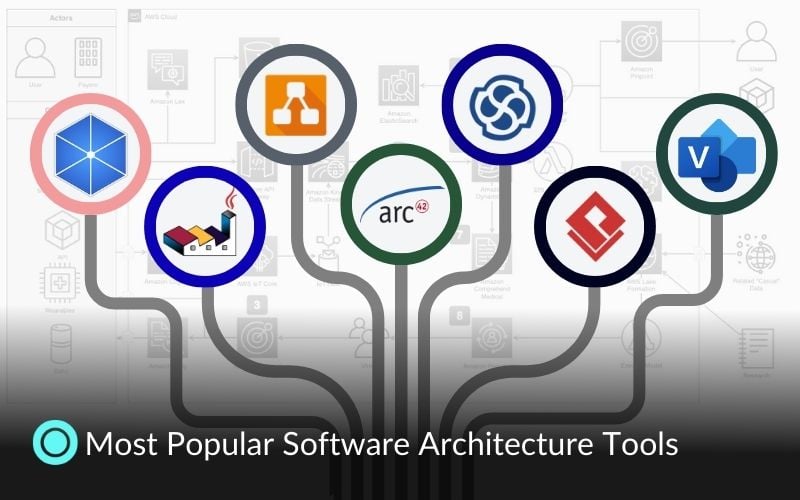Choosing the right software architecture tools in 2025 is not simple, teams face many needs, from clear diagrams to living docs and code views. This guide gives you a clean software architecture tools list and shows what each tool is good at. You will also see which ones are free or open source software architecture tools.
Why Do We Need/Use Software Architecture Tools?
Creating modern software systems involves many layers of design from the technical architecture to team communication. Relying solely on verbal descriptions or ad-hoc drawings typically leads to miscommunications. This is where specialized tools make a difference, because they turn abstract ideas into something concrete and reusable.
-
Clear Diagrams
Tools allow architects to draw system layouts using standardized languages and symbols. These diagrams provide a common understanding of how parts of the system are interconnected. -
Structured Documentation
A good tool stores decisions and design details in a transferable and updatable format. This makes onboarding easier and prevents knowledge loss when team members change. -
Quality Checks
Some of the solutions extend beyond the drawing and can identify weak spots, like performance risk or potential security issues. That helps teams act before these problems show up in production. -
Decision Support
Dashboards, reports, and visual outputs allow managers and architects to consider alternatives and agree on the right path. -
Team Alignment
With features like shared editing or cloud access, tools keep architects, developers, and business stakeholders on the same page, even if they work in different locations.
Because projects vary in size and complexity, not every team needs the same kind of tool. Some require enterprise-scale modeling, others want lightweight diagramming, and some focus on linking designs directly to code. That is why comparing different software architecture tools is so valuable before choosing one.
Top 7 Most Popular Software Architecture Tools
1. Arc42
arc42 is an open-source template that helps software teams explain and document their architecture in a clear way. Instead of being another drawing tool, it gives you a ready-made structure so you don’t forget the important parts of your system.
Features
-
Comes with 12 easy-to-follow sections like goals, context, building blocks, runtime, deployment, decisions, and risks
-
Works with any format you prefer, from Word and wikis to UML tools
-
Keeps documentation practical and to the point, so you only write what others actually need
-
100% free to use, both for personal and commercial projects
Purpose
arc42 makes architecture documentation easier. It helps teams create something structured and understandable without wasting time on unnecessary details.
Strengths
-
Free and open source with no license costs
-
Flexible, since it fits with many tools you may already use
-
Helps you stay organized and clear, so nothing important gets lost
Weaknesses
-
It’s not a drawing tool and doesn’t create diagrams on its own
-
For very small projects, the structure can feel a bit too much
2. draw.io (diagrams.net)
draw.io, also known as diagrams.net, is one of the easiest ways to make diagrams online. You can open it in your browser without installing anything, or download the desktop app if you prefer. Because it’s free and open source, many teams use it to sketch everything from quick flowcharts to full software architecture diagrams.
Features
-
Free to use, no license or hidden costs
-
Works both in the browser and as a desktop app
-
Comes with a large library of ready-to-use shapes for UML, BPMN, ER, and architecture diagrams
-
Connects to cloud storage like Google Drive, OneDrive, Dropbox, and GitHub
-
Lets teams work together and keep versions of diagrams
-
Exports to popular formats like PNG, SVG, PDF, and XML
Purpose
draw.io is meant for anyone who needs fast and simple diagrams. It’s lightweight, easy to pick up, and perfect for sharing visuals without complex setup.
Strengths
-
Completely free and open source
-
Very easy to use with a drag-and-drop editor
-
Works online and offline, so you’re never stuck
-
Integrates smoothly with tools like Confluence, GitHub, and cloud storage
Weaknesses
-
Doesn’t offer advanced modeling or enterprise-level features
-
No support for simulation or in-depth analysis
-
Very large diagrams can become hard to manage
3. PlantUML
PlantUML is a bit different from most diagramming tools. Instead of dragging and dropping shapes, you write text, and the tool turns that text into diagrams. It’s free, open source, and especially loved by developers because diagrams can live right next to the source code.
Features
-
Supports many types of diagrams: UML (class, sequence, use case), ArchiMate, ER, and even C4
-
Text-based input, so diagrams can be stored in Git or other repositories
-
Works with popular IDEs like IntelliJ IDEA, Visual Studio Code, and Eclipse
-
Can be part of automated workflows in CI/CD pipelines
-
Plugins and integrations for tools like Confluence, GitHub, and web-based rendering
Purpose
PlantUML makes it possible to create and update diagrams like code. This keeps visuals versioned, reproducible, and always in sync with the project.
Strengths
-
Free and open source
-
Fits naturally into developer workflows
-
Easy to keep diagrams up to date alongside code
-
Supports many different standards, from UML to C4
Weaknesses
-
Less friendly for non-technical users
-
Visuals are more basic compared to tools like draw.io or Visio
-
Complex diagrams can become difficult to maintain in plain text
4. Archi (ArchiMate – TOGAF)
Archi is a free, open-source tool designed for enterprise architecture modeling. It uses the ArchiMate language, a standard created by The Open Group, and is especially useful for organizations that work with frameworks like TOGAF.
Features
-
Full support for the ArchiMate modeling language
-
Built for enterprise and business architecture diagrams
-
Free and open source, easy to download and start using
-
Includes the coArchi plugin, which lets teams collaborate and version models with Git
-
Allows you to create different viewpoints across business, application, and technology layers
Purpose
Archi helps enterprise architects map out large and complex systems in a consistent way, following standards that big organizations already know and trust.
Strengths
-
Completely free and open source
-
Works hand in hand with TOGAF and industry practices
-
Handles complex enterprise models well
-
Collaboration is supported through Git with the coArchi plugin
Weaknesses
-
Aimed at enterprise-level projects, not the best fit for small teams
-
Has a steeper learning curve than simple diagram tools
-
Limited outside the ArchiMate language, so less flexible than general-purpose tools
Featured Resource:
TOGAF vs iSAQB: A Detailed Comparison
5. Enterprise Architect
Enterprise Architect by Sparx Systems is a full-featured modeling platform that many large companies rely on. It supports a wide range of standards and covers everything from business processes to detailed software design.
Features
-
Supports UML, SysML, BPMN, ArchiMate, and more
-
Covers the entire process: from requirements to deployment
-
Includes tools for simulation, testing, and validation
-
Collaboration features like shared repositories and role-based access
-
Integrates with databases, plus code generation and reverse engineering
Purpose
Enterprise Architect is built to give organizations a complete environment for modeling. It brings business, system, and software layers together in one place.
Strengths
-
Extremely feature-rich and versatile
-
Works well for large teams and complex projects
-
Provides in-depth analysis and validation tools
-
Used widely in industries like automotive, finance, and government
Weaknesses
-
It’s a commercial tool, so you need a license
-
Has a steep learning curve due to its complexity
-
Often too much for small teams or lightweight projects
6. Visual Paradigm
Visual Paradigm is a commercial tool that combines modeling and diagramming with support for many different notations. It’s designed to bridge both business and technical needs, from early requirements all the way to deployment.
Features
-
Supports UML, BPMN, ArchiMate, ERD, SysML, and more
-
Cloud-based collaboration and team management
-
Ready-to-use templates for agile development, requirements gathering, and project planning
-
Code engineering options such as generation and reverse engineering
-
Integrates with IDEs and platforms like Jira, Confluence, and others
Purpose
The goal of Visual Paradigm is to provide a multi-purpose platform that connects business process design with software system architecture, so teams can manage both in one tool.
Strengths
-
Covers a wide range of modeling languages and standards
-
Strong collaboration options through its cloud edition
-
Built-in support for agile workflows and project management
-
Flexible deployment options: desktop, cloud, or server-based
Weaknesses
-
Requires a paid license, there is no completely free version
-
The many features can feel overwhelming for smaller teams
-
Some cloud-based features depend on your subscription plan
7. Microsoft Visio
Microsoft Visio is one of the most recognizable diagramming tools in the Microsoft ecosystem. It isn’t designed just for software architecture, but many teams use it for technical diagrams, workflows, and process maps because it’s already available in many companies.
Features
-
Large library of shapes and templates, including UML stencils
-
Works with Microsoft 365 and SharePoint for easy collaboration
-
Available as both a cloud and desktop version
-
Can export diagrams to formats like PDF, SVG, and images
-
Real-time co-authoring in the cloud edition
Purpose
Visio is meant to be a general-purpose diagramming tool that can handle everything from organizational charts to IT and software architecture diagrams.
Strengths
-
Familiar interface for anyone used to Microsoft Office
-
Strong collaboration through Microsoft 365 integration
-
Already widely used in many corporate environments
-
Flexible enough for many kinds of diagrams beyond IT systems
Weaknesses
-
Requires a commercial license, there’s no free version
-
Lacks advanced features found in specialized architecture tools
-
Can feel too generic compared to tools built for software architects
A Comparison of the Best Software Architecture Tools
Criteria for Evaluating the Best Software Architecture Tools
Not every architecture tool is built for the same job. Some are better for drawing diagrams, others for documenting decisions, and some focus on connecting directly with code. To compare them in a fair way, we look at criteria that match the real problems architects deal with in their daily work:
-
Diagramming and Modeling – Does the tool help create clear, understandable diagrams using standard notations?
-
Design and Analysis – Can it point out risks, quality issues, or performance limits?
-
Cloud Architecture Design – Is it ready for today’s cloud-native and distributed systems?
-
Collaboration and Documentation – Does it make it easy for teams to share knowledge and work together?
-
Code Analysis and Visualization – Can the tool link models with code or create diagrams from existing code?
-
Simulation and Testing – Is it able to test ideas or simulate behavior before building the real system?
By looking at tools through these lenses, it becomes clear where each one shines and where it might fall short. This makes the comparison practical and useful for teams with different needs.
How to Choose the Best Tool for Your Needs
When you think of the software architecture tools list, the best tool isn't the one with the most features but the one that is appropriate for your situation.
Every team and project is one of a kind and therefore the smart thing is matching the options with your needs.
Below are the questions for deciding help:
-
Do you need clear documentation easily understood and reusable by others?
-
Do you want fast and effortless diagrams, or are you after something capable of dealing with enterprise-level modeling?
-
Would your team be more productive with a visual drag-and-drop editor or with text-based diagrams that can live inside your code repository?
-
Are you part of a small budget team or a large corporation where the simulation and code generation capabilities become more relevant?
-
How important is collaboration? Do you need cloud-based teamwork, or is local editing enough?
-
Do you need an open source, free tool, or can you afford for a commercial suite with advanced support?
By answering these questions, you’ll have a clear idea within minutes which tools from the table above suit your case. It’s not about choosing the “best” tool overall, but the tool that enables your team to work smarter and deliver better results.
Summary
Software architecture tools make it easier to design, document, and share complex systems. Some focus on diagrams, others focus on structured documentation, and some integrate enterprise-scale modeling into one platform.
There is no single tool for everything. The right one depends on your project size, your team work style, and your goals. Use the table for comparing and the guiding questions to find the tool that best fits your needs.





